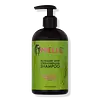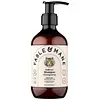What's inside
What's inside
 Key Ingredients
Key Ingredients

No key ingredients
 Benefits
Benefits

 Concerns
Concerns

 Ingredients Side-by-side
Ingredients Side-by-side

Water
Skin ConditioningSodium C14-16 Olefin Sulfonate
CleansingCocamidopropyl Betaine
CleansingPolyquaternium-7
Cocamide Mipa
EmulsifyingGlycol Stearate
EmollientPolyquaternium-10
Panthenol
Skin ConditioningPropylene Glycol
HumectantMentha Piperita Oil
MaskingRosmarinus Officinalis Leaf Oil
MaskingDisodium EDTA
Phytantriol
HumectantOrbignya Oleifera Seed Oil
EmollientZingiber Officinale Root Oil
MaskingCocos Nucifera Oil
MaskingEquisetum Arvense Extract
AstringentLawsonia Inermis Extract
AntimicrobialRosmarinus Officinalis Extract
AntimicrobialAnthemis Nobilis Flower Extract
MaskingSymphytum Officinale Callus Culture Extract
Skin ConditioningHumulus Lupulus Extract
AntimicrobialUrtica Dioica Extract
AstringentHoney
HumectantBiotin
AntiseborrhoeicRicinus Communis Seed Oil
MaskingPhenoxyethanol
PreservativeBenzoic Acid
MaskingEthylhexylglycerin
Skin ConditioningGlycereth-2 Cocoate
EmulsifyingParfum
MaskingWater, Sodium C14-16 Olefin Sulfonate, Cocamidopropyl Betaine, Polyquaternium-7, Cocamide Mipa, Glycol Stearate, Polyquaternium-10, Panthenol, Propylene Glycol, Mentha Piperita Oil, Rosmarinus Officinalis Leaf Oil, Disodium EDTA, Phytantriol, Orbignya Oleifera Seed Oil, Zingiber Officinale Root Oil, Cocos Nucifera Oil, Equisetum Arvense Extract, Lawsonia Inermis Extract, Rosmarinus Officinalis Extract, Anthemis Nobilis Flower Extract, Symphytum Officinale Callus Culture Extract, Humulus Lupulus Extract, Urtica Dioica Extract, Honey, Biotin, Ricinus Communis Seed Oil, Phenoxyethanol, Benzoic Acid, Ethylhexylglycerin, Glycereth-2 Cocoate, Parfum
Water
Skin ConditioningSodium Cocoyl Isethionate
CleansingAloe Barbadensis Leaf Juice
Skin ConditioningCocamidopropyl Hydroxysultaine
CleansingParfum
MaskingDecyl Glucoside
CleansingLauryl Glucoside
CleansingSodium Lauroyl Sarcosinate
CleansingMaltitol
HumectantXylitol
HumectantXylitylglucoside
HumectantAnhydroxylitol
HumectantCocos Nucifera Oil
MaskingHelianthus Annuus Seed Oil
EmollientPueraria Lobata Root Extract
HumectantBacopa Monnieri Extract
Skin ConditioningEclipta Prostrata Extract
Skin ConditioningPelvetia Canaliculata Extract
Skin ProtectingAegle Marmelos Root Extract
Skin ConditioningCentella Asiatica Extract
CleansingDesmodium Gangeticum Root Extract
Skin ConditioningGmelina Arborea Root Extract
Skin ConditioningOroxylum Indicum Root Extract
Skin ConditioningPremna Serratifolia Root Extract
Skin ConditioningSolanum Indicum Root Extract
Skin ConditioningSolanum Xanthocarpum Root Extract
MaskingStereospermum Suaveolens Root Extract
Skin ConditioningTribulus Terrestris Root Extract
Skin ConditioningOrbignya Speciosa Kernel Oil
EmollientCurcuma Longa Root Extract
MaskingMelia Azadirachta Leaf Extract
Skin ConditioningPhyllanthus Emblica Fruit Extract
HumectantWithania Somnifera Root Extract
Skin ConditioningAstrocaryum Murumuru Seed Butter
EmollientLinum Usitatissimum Seed Oil
PerfumingHibiscus Sabdariffa Flower Extract
Skin ConditioningTrigonella Foenum-Graecum Seed Extract
PerfumingHydroxypropyl Guar Hydroxypropyltrimonium Chloride
Hydrolyzed Wheat Protein Pg-Propyl Silanetriol
Skin ConditioningEthylhexylglycerin
Skin ConditioningPolyquaternium-10
Polyquaternium-7
Glycerin
HumectantCoconut Acid
CleansingSodium Isethionate
CleansingSodium Lauroyl Lactylate
EmulsifyingCoco-Glucoside
CleansingDisodium Cocoyl Glutamate
CleansingGlyceryl Oleate
EmollientCitric Acid
BufferingPotassium Sorbate
PreservativePhenoxyethanol
PreservativeLeuconostoc/Radish Root Ferment Filtrate
AntimicrobialCoumarin
PerfumingWater, Sodium Cocoyl Isethionate, Aloe Barbadensis Leaf Juice, Cocamidopropyl Hydroxysultaine, Parfum, Decyl Glucoside, Lauryl Glucoside, Sodium Lauroyl Sarcosinate, Maltitol, Xylitol, Xylitylglucoside, Anhydroxylitol, Cocos Nucifera Oil, Helianthus Annuus Seed Oil, Pueraria Lobata Root Extract, Bacopa Monnieri Extract, Eclipta Prostrata Extract, Pelvetia Canaliculata Extract, Aegle Marmelos Root Extract, Centella Asiatica Extract, Desmodium Gangeticum Root Extract, Gmelina Arborea Root Extract, Oroxylum Indicum Root Extract, Premna Serratifolia Root Extract, Solanum Indicum Root Extract, Solanum Xanthocarpum Root Extract, Stereospermum Suaveolens Root Extract, Tribulus Terrestris Root Extract, Orbignya Speciosa Kernel Oil, Curcuma Longa Root Extract, Melia Azadirachta Leaf Extract, Phyllanthus Emblica Fruit Extract, Withania Somnifera Root Extract, Astrocaryum Murumuru Seed Butter, Linum Usitatissimum Seed Oil, Hibiscus Sabdariffa Flower Extract, Trigonella Foenum-Graecum Seed Extract, Hydroxypropyl Guar Hydroxypropyltrimonium Chloride, Hydrolyzed Wheat Protein Pg-Propyl Silanetriol, Ethylhexylglycerin, Polyquaternium-10, Polyquaternium-7, Glycerin, Coconut Acid, Sodium Isethionate, Sodium Lauroyl Lactylate, Coco-Glucoside, Disodium Cocoyl Glutamate, Glyceryl Oleate, Citric Acid, Potassium Sorbate, Phenoxyethanol, Leuconostoc/Radish Root Ferment Filtrate, Coumarin
 Reviews
Reviews

Ingredients Explained
These ingredients are found in both products.
Ingredients higher up in an ingredient list are typically present in a larger amount.
Cocos Nucifera Oil is obtained from the kernels of the coconut fruit. In other words, this is coconut oil.
Coconut Oil is rich in fatty acids with lauric acid making up the majority of these. It also contains linoleic acid. Due to this high fatty acid content, coconut oil helps trap moisture and soften skin.
Despite being antibacterial, coconut oil may not be great for acne-prone skin. It is comedogenic and may clog pores. This ingredient may not be safe for malassezia or fungal acne.
Note: Coconut Oil should not replace your sunscreen for UV protection. Studies show it only blocks about 20% of UV.
This oil is non-volatile and has a light scent.
The term 'fragrance' is not regulated in many countries. In many cases, it is up to the brand to define this term. For instance, many brands choose to label themselves as "fragrance-free" because they are not using synthetic fragrances. However, their products may still contain ingredients such as essential oils that are considered a fragrance.
Learn more about Cocos Nucifera OilEthylhexylglycerin (we can't pronounce this either) is commonly used as a preservative and skin softener. It is derived from glyceryl.
You might see Ethylhexylglycerin often paired with other preservatives such as phenoxyethanol. Ethylhexylglycerin has been found to increase the effectiveness of these other preservatives.
Parfum is a catch-all term for an ingredient or more that is used to give a scent to products.
Also called "fragrance", this ingredient can be a blend of hundreds of chemicals or plant oils. This means every product with "fragrance" or "parfum" in the ingredients list is a different mixture.
For instance, Habanolide is a proprietary trade name for a specific aroma chemical. When used as a fragrance ingredient in cosmetics, most aroma chemicals fall under the broad labeling category of “FRAGRANCE” or “PARFUM” according to EU and US regulations.
The term 'parfum' or 'fragrance' is not regulated in many countries. In many cases, it is up to the brand to define this term.
For instance, many brands choose to label themselves as "fragrance-free" because they are not using synthetic fragrances. However, their products may still contain ingredients such as essential oils that are considered a fragrance by INCI standards.
One example is Calendula flower extract. Calendula is an essential oil that still imparts a scent or 'fragrance'.
Depending on the blend, the ingredients in the mixture can cause allergies and sensitivities on the skin. Some ingredients that are known EU allergens include linalool and citronellol.
Parfum can also be used to mask or cover an unpleasant scent.
The bottom line is: not all fragrances/parfum/ingredients are created equally. If you are worried about fragrances, we recommend taking a closer look at an ingredient. And of course, we always recommend speaking with a professional.
Learn more about ParfumPhenoxyethanol is a preservative that has germicide, antimicrobial, and aromatic properties. Studies show that phenoxyethanol can prevent microbial growth. By itself, it has a scent that is similar to that of a rose.
It's often used in formulations along with Caprylyl Glycol to preserve the shelf life of products.
Polyquaternium-10 is an ammonium salt of hydroxyethylcellulose. It is a white and granular powder used as a film-former and anti-static agent.
This ingredient is commonly found in hair conditioning products. According to a manufacturer, its positive charge makes it great for absorbing hair proteins. The manufacturer also states this ingredient helps with curl retention.
For haircare friends: this ingredient is not a silicone.
Learn more about Polyquaternium-10Polyquaternium-7 is a light to clear colored liquid. It is commonly found in haircare products for its film-forming and anti-static properties.
According to a manufacturer, it is a non-paraben and specially developed for negatively charged surfactant systems. This makes it a great hairstyle holder and helps to improve wet hair detangling without adding buildup.
Water. It's the most common cosmetic ingredient of all. You'll usually see it at the top of ingredient lists, meaning that it makes up the largest part of the product.
So why is it so popular? Water most often acts as a solvent - this means that it helps dissolve other ingredients into the formulation.
You'll also recognize water as that liquid we all need to stay alive. If you see this, drink a glass of water. Stay hydrated!
Learn more about Water